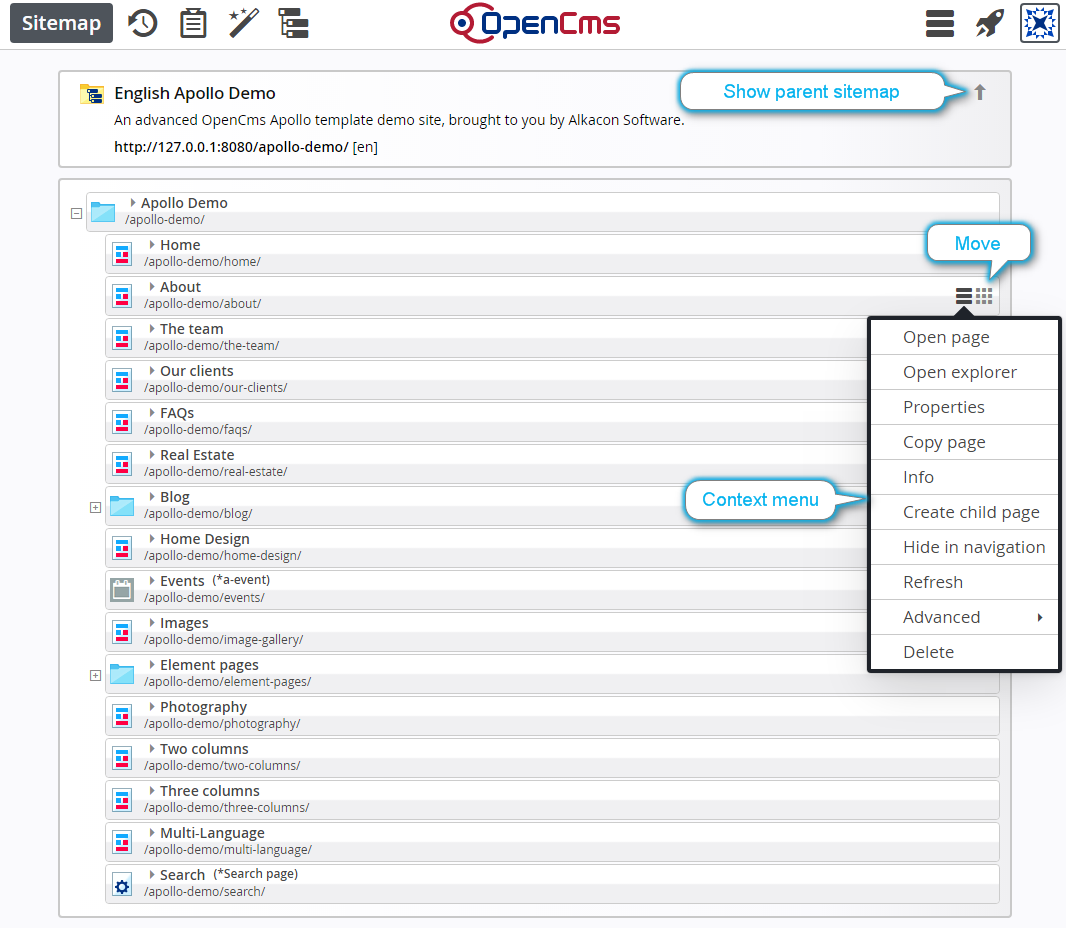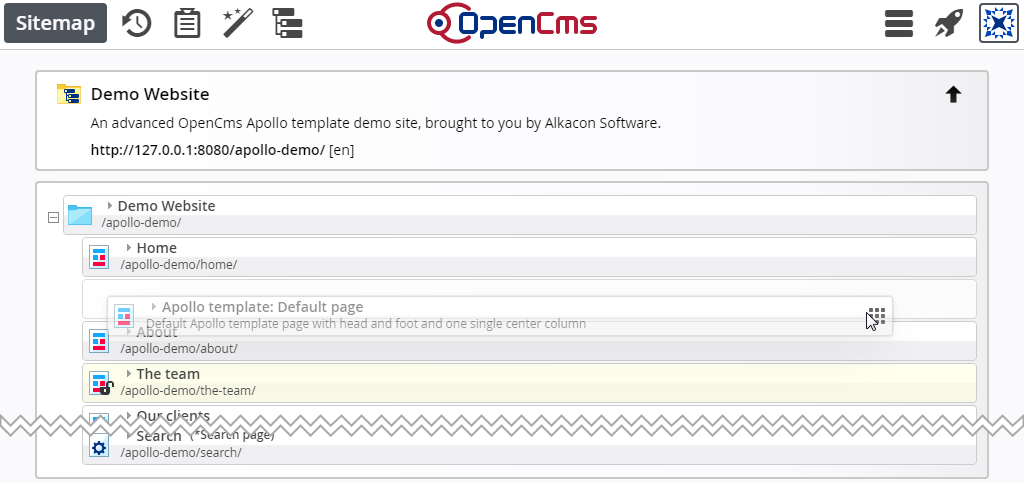From the quick launch menu in the toolbar, choose the Sitemap app.
The sitemap editor allows you to build the site’s navigation structure by creating new container pages and changing the navigation information of the existing pages. The sitemap represents the website’s structure displaying the container page tree. The user can drop new container pages to different levels of the navigation tree, enter further information like title, create new sub sitemaps or change the order of the pages with drag & drop. The sitemap hierarchy describes the navigation structure of the website and is co-responsible for the URLs visible to the public. It approximates the file tree in the Virtual File System (VFS) of OpenCms but does not cover it exactly.
Moreover, the sitemap editor has various other views where you can
- View and edit all resources in the VFS
- Edit, add or remove galleries (image and download galleries)
- Add, edit and remove template models and model group pages
- Add, edit and remove categories
The sitemap editor displays the page tree in the order it appears in the navigation. When moving the mouse over a page (sitemap entry) two options are displayed on the right side of the bar: Context menu and Move. The context menu allows to display information about and perform operations on the chosen sitemap entry. Depending on the type of the sitemap entry, the menu can differ.
The screenshot shows options of the sitemap editor, that are available additionally to the toolbar options.

-
Opens the Publish dialog.
-

-
-

-
-
-

With the Add pages option from the sitemap editor's toolbar you can add a new page via drag & drop. You can create three different kinds of pages: Container pages, Detail pages, and Function pages.

Depending on the configured template models provided by the template developer, you can select from different pages meeting your requirements. You can drop a new container page to wherever you need it in the sitemap.

A page can be dropped right below another existing page or as a child page of an existing page. If you want to place the page 2 as child page of page 1, hover over the icon of page 1. Then page 2 will become a child page of it - if dragged right below. A child page can also be created via the "Create child page" context menu entry on an existing page.
Via the tab Detail pages from the Add pages dialog one can create a new sitemap entry that is used as detail page for a certain content type or function, e.g., for news articles. Detail pages are used to link from lists of contents to detailed views on these entries or to e.g., search results. Read more about the detail pages here:
Selecting the Function pages option from the Add pages dialog offers a selection of pages for special purpose.

Function pages available
- HTML redirect
A HTML Redirect might be accessible through the page navigation and redirects the browser to another URI within the site or to an external link. It might also be excluded from navigation but necessary if a page / sub-site has moved to another location and to prevent dead links from users' bookmarks.
When selecting the Clipboard ![]() option from the sitemap toolbar, the clipboard opens in an overlay window. It features two lists of recently edited pages in the sitemap editor.
option from the sitemap toolbar, the clipboard opens in an overlay window. It features two lists of recently edited pages in the sitemap editor.
Tabs of the clipboard
- Modified
The modified list will be displayed as default and contains pages that have recently been modified in the sitemap editor. When you move the mouse over a list entry, an option appears on the right side of the bar, which shows an option to display the page in the sitemap editor. If clicked, the overlay window is closed and the selected page will show up blinking in the editor.
Selecting the Select view ![]() option from the toolbar, you can change the view of the sitemap editor. The following views are available.
option from the toolbar, you can change the view of the sitemap editor. The following views are available.
The sitemap editors views
- Resources
Shows the site's folder tree containing all resources in the Virtual File System of OpenCms.
- Galleries
Shows the galleries (image and download galleries) that are stored in the current sitemap. You can add, edit or remove galleries.
- Categories
Shows the categories available in the current sitemap. Local categories, i.e., categories defined in the current sitemap can be edited. Global categories, i.e., categories defined in some parent sitemap or system wide, can only be viewed.
- Compare locales
A special view to manage locale variants of pages. See here for more information on multilingual websites in OpenCms.
Context menu
The Context menu displays all available options of the current sub sitemap.
- Show parent sitemap
Shows the parent sitemap of the current sitemap. The options appears only in sub-sitemaps.
- Advanced > Edit aliases
Shows the "Edit aliases dialog" for the sitemap. Read more here.
- Advanced > Sitemap configuration
Opens the sitemap's configuration.
